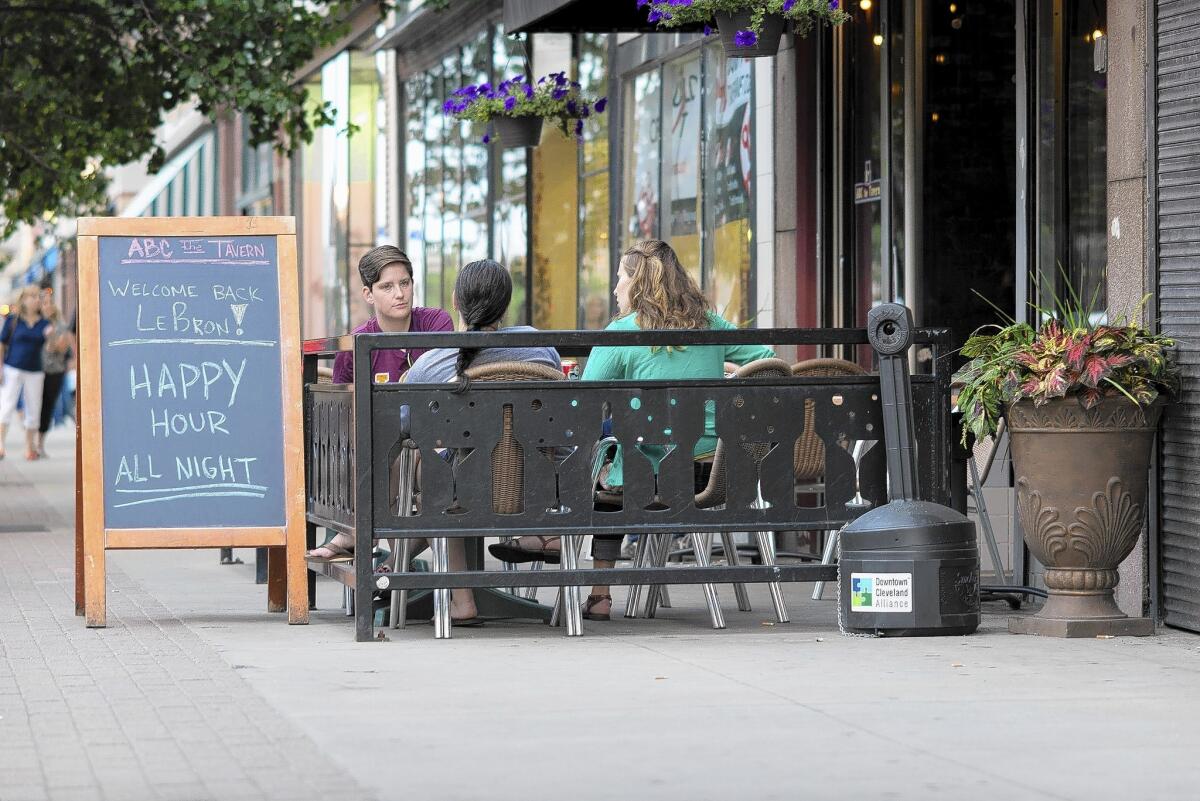Cleveland has been on the rebound even before LeBron James news

- Share via
Reporting from CLEVELAND — Two years before LeBron James decided to make “bringing one trophy back to northeast Ohio” his new priority, Roz Quarto decided to pick up and move to Cleveland for no other reason than it seemed like a nice place. Friends in her hometown of New York City all reacted as if in unison.
“They said, ‘Cleveland, as in, Ohio?’” Quarto, 48, said while sitting on a bustling patio surrounded by blooming flower boxes in this city’s Ohio City neighborhood.
------------
FOR THE RECORD:
Cleveland resurgence: An article in Section A on July 15 about how Cleveland is booming said the number of college-educated people between the ages of 25 and 34 had increased 68% in the city between 2006 and 2012. The increase was 23% during that time. —
------------
Now, she and her partner own a big yellow house not far from this neighborhood, which was recently named by USA Today as one of the top 10 places in the world to barhop, alongside New Orleans, Rio de Janeiro and Dublin, Ireland. And when friends from New York come to visit, Quarto says, they get it and are happy to help the couple tick off another thing on their Cleveland bucket list. (The list includes visiting the Botanical Garden and going to a high school football game.)
Her partner’s boss, who lives in Alaska, even purchased a second home in Cleveland.
The news trifecta of James moving back to his hometown Cavaliers, hotshot college quarterback Johnny Manziel signing with the NFL’s beleaguered Cleveland Browns, and the Republican Party picking the Cleve for its 2016 national convention may have put the city in the spotlight in recent days, but locals say all of it is simply more proof there’s a Cleveland resurgence underway.
“The GOP and LeBron are going to grease the skids on a process that’s already started,” said Richey Piiparinen, a senior research associate at the Center for Population Dynamics at Cleveland State University. “People are realizing it’s not your grandpa’s Rust Belt anymore.”
Changes are already evident in the city, where new construction is booming. Hammers and drills sound at all hours on the Flats East Bank, a onetime hip area that fell into disarray a decade ago and is experiencing a renaissance. Downtown, a new convention center just opened, and developers are rushing to build hotels and luxury condos to keep up with demand. Ohio’s first casino opened downtown in 2012. And restaurateurs are following in the steps of Cleveland native and James Beard Award winner Michael Symon, opening bistros where you can get entrees such as frog legs and rabbit pie with Parmesan and prosciutto crust.
To be sure, Cleveland still has its problems. Poverty is rampant, with half of the city’s children living in poverty in 2012, a rate second only to that of Detroit, according to the National Center for Children in Poverty. The years of out-migration have led to neighborhoods of vacant homes, something that became all too evident last year when three women escaped from a basement where they’d been held captive for years by Ariel Castro.
“It’s still same old, same old here,” said Vickie Williams, who has lived for eight years just blocks from the Castro house. She works downtown and has seen the changes there, but says that no boom has trickled into her neighborhood, where people still beg for money outside the Dollar General and tall weeds grow in empty lots where houses once stood.
Still, Cuyahoga County received more in-migration from Brooklyn and Chicago between 2007 and 2011 than it sent to those places, Piiparinen said. Although the Cleveland area lost population between 2006 and 2012, it added 40,000 people with college degrees during that period, and the number of educated 25- to 34-year-olds grew 68%, according to Piiparinen’s research.
Many young people fled Cleveland and other Rust Belt cities in the 2000s for places such as Chicago, San Francisco and New York, Piiparinen said. But as those cities became more crowded with transplants, costs began rising and many people were priced out. Now, he said, there’s a push-back against the “Brooklynization” of these big cities, and people are moving home. And not just to Cleveland — to Pittsburgh, St. Louis and Buffalo, N.Y., as well.
“It’s what we call ‘big fish, small pond’ talent migration. Are you going to get lost in the shuffle of New York City, or are you going to come back and make a huge difference in your community?” Piiparinen said.
Roz Quarto was motivated to move to Cleveland in part by the high cost of living in the New York metro area, where she feared she and her partner would never get ahead financially. Quarto started thinking about Cleveland when she was on the selection committee of the Gay Games, which will be held in this city next month. On a road trip from Alaska to New York, Quarto and her partner, Gail L. Palmer, stopped in Cleveland and intended to stay three days. They stayed for 10. It wasn’t long before they decided to try living here.
“We figured we’d see if we liked it, and sign a year lease,” Quarto said. “Then we fell deeper and deeper in love with the city.”
When LeBron defected in 2010, the city had gone through a rough few years. Northeast Ohio suffered as the rest of the country did during the recession, and the unemployment rate peaked at 9.3% in August 2009. In 2008, the FBI and Internal Revenue Service raided offices of a Cuyahoga County commissioner, triggering a corruption investigation that would lead to a salacious trial and the conviction of the commissioner on racketeering and corruption charges.
In late 2010, developers announced that the Flats East Bank project, which had been stalled since the recession, received the funding to begin building. In January 2011, the city broke ground on a $465-million medical mart and convention center complex. And something about Cleveland was beginning to lure back young people. Like LeBron, they just needed some time elsewhere before they returned.
“The first inclination that college-age kids in Cleveland used to have was to flee,” said Adam Fishman, a principal with Fairmount Properties, which is developing the Flats. “Somehow that has now changed.”
In the Flats these days, not far from where the Cuyahoga River infamously caught fire in 1969, people in business clothes pour in and out of the Ernst & Young glass tower, which is 96% leased. Cleveland native Natalia Martinovic, who in January moved her family to Cleveland from Silicon Valley, works in the Flats.
“When I was a kid, there was nothing to do here,” she said. “Now, you can feel the energy.”
Of course, the potential prowess of the city’s sports teams doesn’t hurt. On a recent weeknight, Matt and Jess Weisenburger were clustered with some friends around a truck where T-shirts were being sold that said “Forgiven,” followed by “The Kingdom Restored.” Priced at $20 apiece, the shirts sold out the day James announced his decision.
The Weisenburgers remembered feeling as though they were punched in the stomach when James said he was leaving. Now, they say, the mood of the city is totally different.
“Everything is just getting busier and busier,” Matt Weisenburger, 34, said. “We have such a worse reputation than we deserve.”
More to Read
Sign up for Essential California
The most important California stories and recommendations in your inbox every morning.
You may occasionally receive promotional content from the Los Angeles Times.











